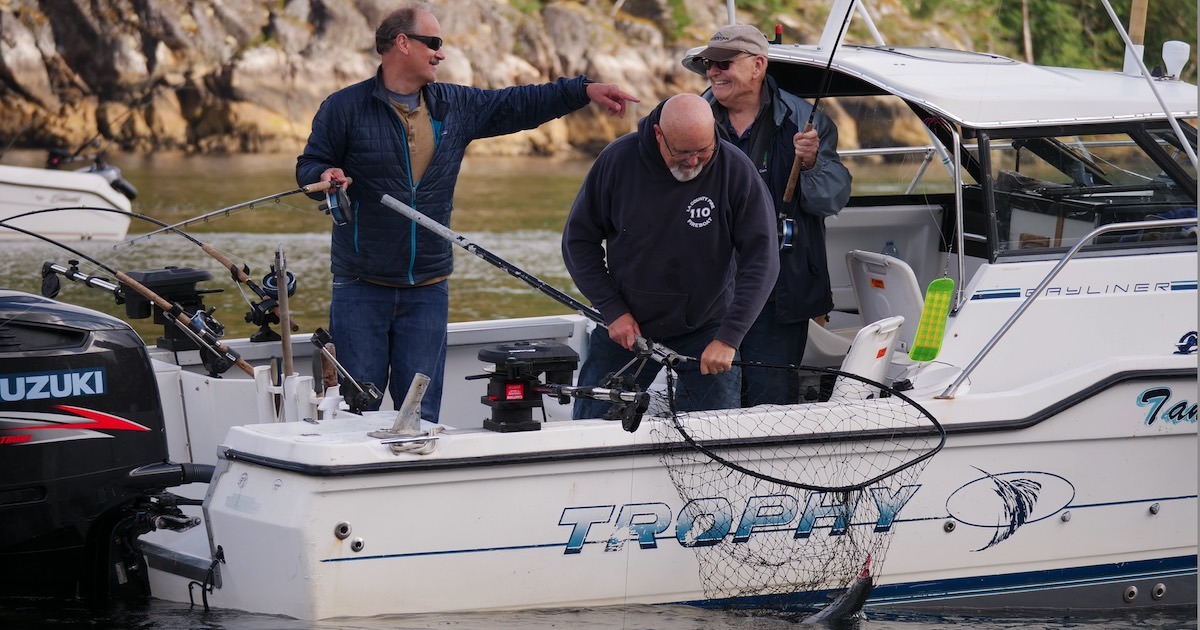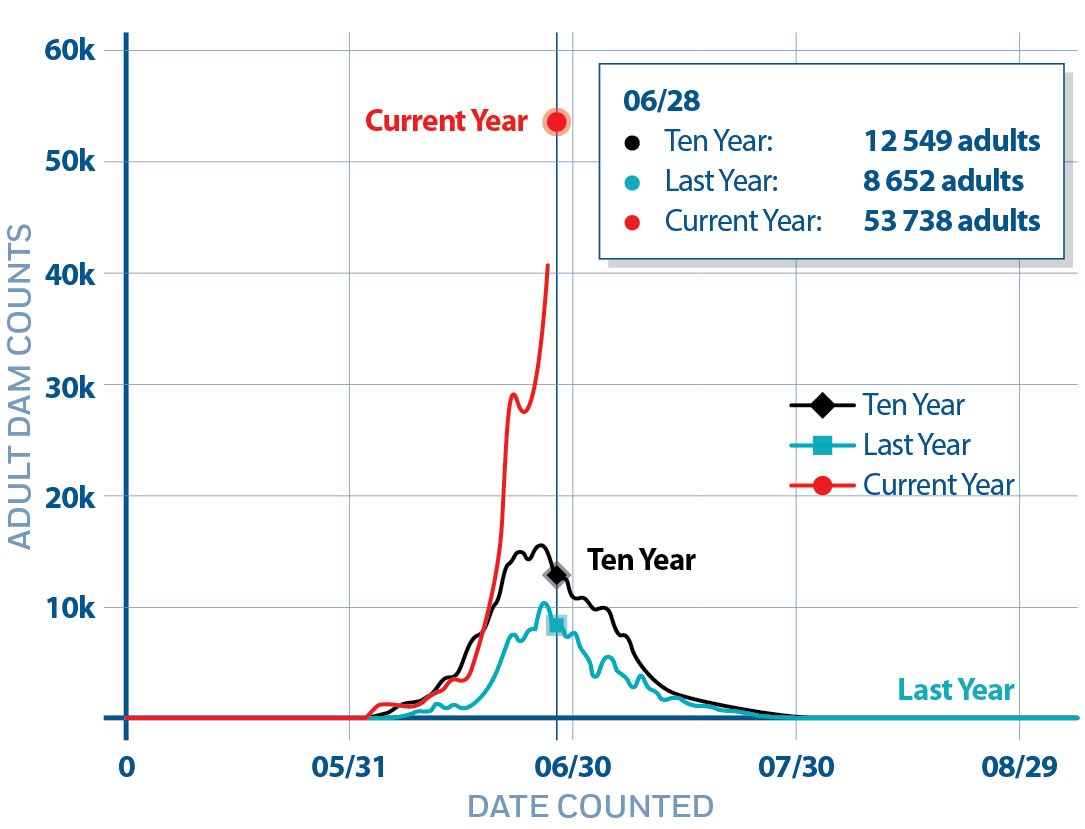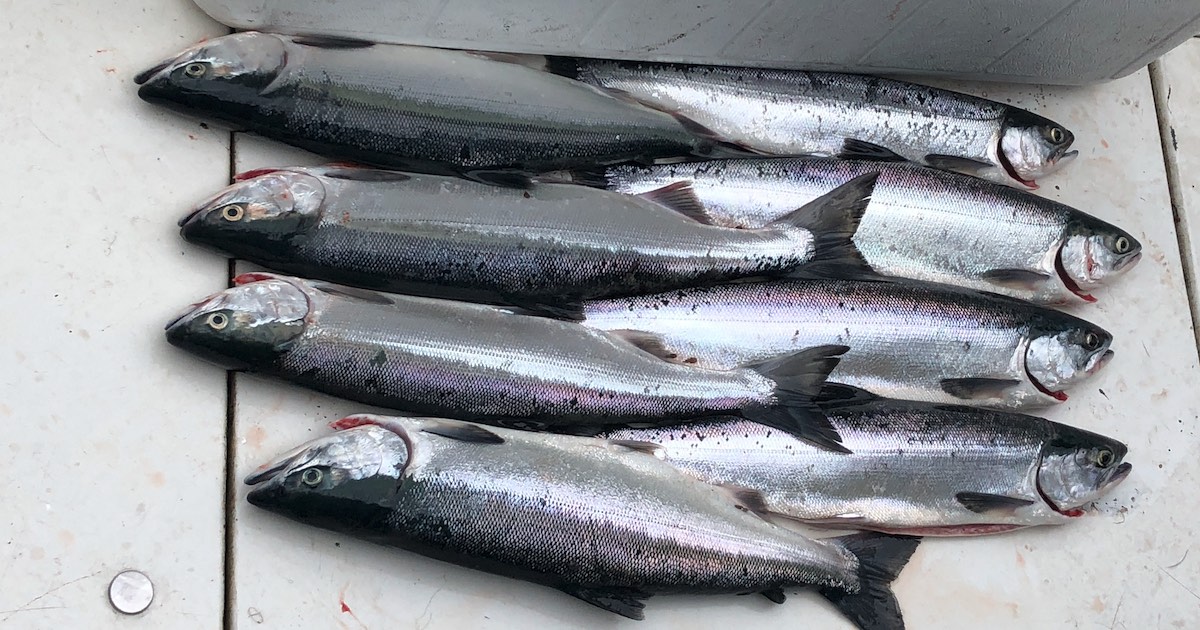
Columbia River Sockeye Returns Making News In BC
News of the largest Columbia River return of sockeye salmon since 1938 has piqued interest in BC, leaving anglers to wonder what BC’s sockeye returns might look like and what angling opportunities might flow from them. This good news story centers on sockeye which spawn in the Columbia’s up-river tributaries. Sockeye escapement is recorded as they pass Bonneville Dam on the lower river. In late June a record 53,738 sockeye went through the counting fence in a single day. This eclipsed the old record, set June 26th 2012, by almost 12,000 fish. As of July 11th 591,134 sockeye have passed Bonneville with a final forecast of 636,500.

Bonneville 2022 sockeye count, data from Fish Passage Center, fpc.org
Becky Johnson is the salmon program manager for the Nez Perce tribes. She noted that “the good sockeye return is likely due to improved ocean conditions” but adds that the “Okanagan Nation Alliance (ONA) built a sockeye hatchery and have been releasing 5 million sockeye annually into the Upper Columbia”. She believes this is a big factor in the record return that, in her words, will “greatly benefits the Tribes and non-tribal fisheries”.
BC Sockeye Outlook
Sockeye return to many BC rivers but the Fraser run is the big show.

According to Fisheries Notice FN0777, covering areas 11-29, this year’s return will be dominated by 4 and 5 year olds, but the run size forecast is still highly uncertain. The notice warns that in years with high discharge the Big Bar slide remains an impediment for all salmon passing the slide. Mitigation measures, including fish transport and brood stock collection, will remain in place this season.
The notice indicates that DFO’s run size forecast probability is as follows:
- 25% probability for less than 4.662 million sockeye.
- 25% for a run size of more than 20.395 million sockeye.
- Consequently fishery managers are working with the 50% probability level. This means there is an equal chance the run being above or below 9.775 million sockeye, which is below the cycle average.
The main stocks contributing are Chilko, Quesnel and late run Shuswap sockeye, of which Shuswap is the only one that spawns below the Big Bar slide.
The predicted diversion of sockeye through Johnstone Strait, relative to those migrating through Juan de Fuca Strait, has been set at 44% by the Pacific Salmon Commission’s Fraser River Panel and the total escapement to the River as of July 21st is estimated to be 266,500.
Fraser River water temperatures are lower this year which is a good thing, but the river discharge is 52% higher than normal which may cause migration delays, and additional mortalities. Consequently DFO management will be adjusting the numbers identified for harvest downwards to assist reaching escapement targets.
Test gillnet fisheries in Juan de Fuca Area 20 have been variable while those at Round Island, near Port Hardy, have been low. Fraser River gillnet test fisheries have been flat in the past week.
As of the July 22nd update First Nations food, societal and ceremonial sockeye fisheries are closed as are commercial and recreational fisheries. Openings are not anticipated until late July or early August in marine waters, and mid August in-river.
Port Alberni
Port Alberni has a long history as a Vancouver Island sockeye fishing destination. Major Somass River sockeye production originates in Sproat and Great Central Lakes.
The most recent regulations allow anglers to keep 4 sockeye per day in the tidal portions of Area 23 extending to the Barkley Sound surf-line, defined by a line from Cape Beale to Amphitrite Point. Exceptions include Uchucklesit Inlet which is closed, even though the run is much larger this year according to Area 23 Harvest Committee member Bob Cole; and the tidal portion of the Somass River with a daily limit of 2 sockeye. Cole added that a very robust fishery was taking place in the River.
The tidal portion of Somass River will be closed to sockeye retention at 00.01 August 2 2022. This provides a one week fishing extension.
Bob Cole adds this piece of advice: Water temperatures have been much cooler and sockeye are entering the river faster and sooner. He suggest anglers could change tactics to shallow fishing with long drop backs off the downrigger wire, or with light in-line weights and lures placed in the top 15 feet.

Sockeye Fishing Vancouver Island
Skeena River
The Skeena watershed is an important northern BC sockeye producer. DFO’s July 20th Fisheries Notice FN0758 confirms that the daily limit for sockeye in statistical areas 3, 4 & 5 is 4 per day until March 31 2023. As of July 27, 2022 Fisheries Notice FN0800 confirmed that,
“Effective immediately, the daily limit for Sockeye is increased to four (4) Sockeye per day in the Skeena River mainstem only as follows:
Effective immediately to September 15, 2022
Skeena River mainstem waters only, upstream of CNR bridge at Terrace to a point above the confluence with the Babine River(Excluding Skeena River mainstem waters near the Kitwanga River mouth, from Mill Creek upstream to the Highway 37 bridge. Also excluding Skeena River mainstem waters within three white triangular fishing boundary signs located at the confluence with the Kispiox River).
Effective immediately to September 15, 2022
Skeena River mainstem waters only, downstream of CNR Railway bridge at Terrace, B.C.(Excluding the Skeena River mainstem waters near the Kitsumkalum River mouth, from the confluence with the Zymagotitz (also known as the Zymachord River) upstream to the Classified Waters boundary at the top of ‘Hells Gate’ until 23:59 hours Aug 31, 2022).”
This year’s return is good news for anglers according to Alex Bussman, owner of Oscar’s Fly & Tackle in Smithers. He adds, “Sockeye are really important for communities in the Skeena region, and one million fish have already passed the Tyee test fishery site”.
On balance it looks like sockeye are a welcome bright spot for BC anglers so far, and it could get brighter if Fraser sockeye follow the trend.
Visit the Store
$34.99
$34.99
Featured Catch

Joel Unickow halibut (Photo: Rob Frawley Lucky Strike Sportfishing Tofino)







